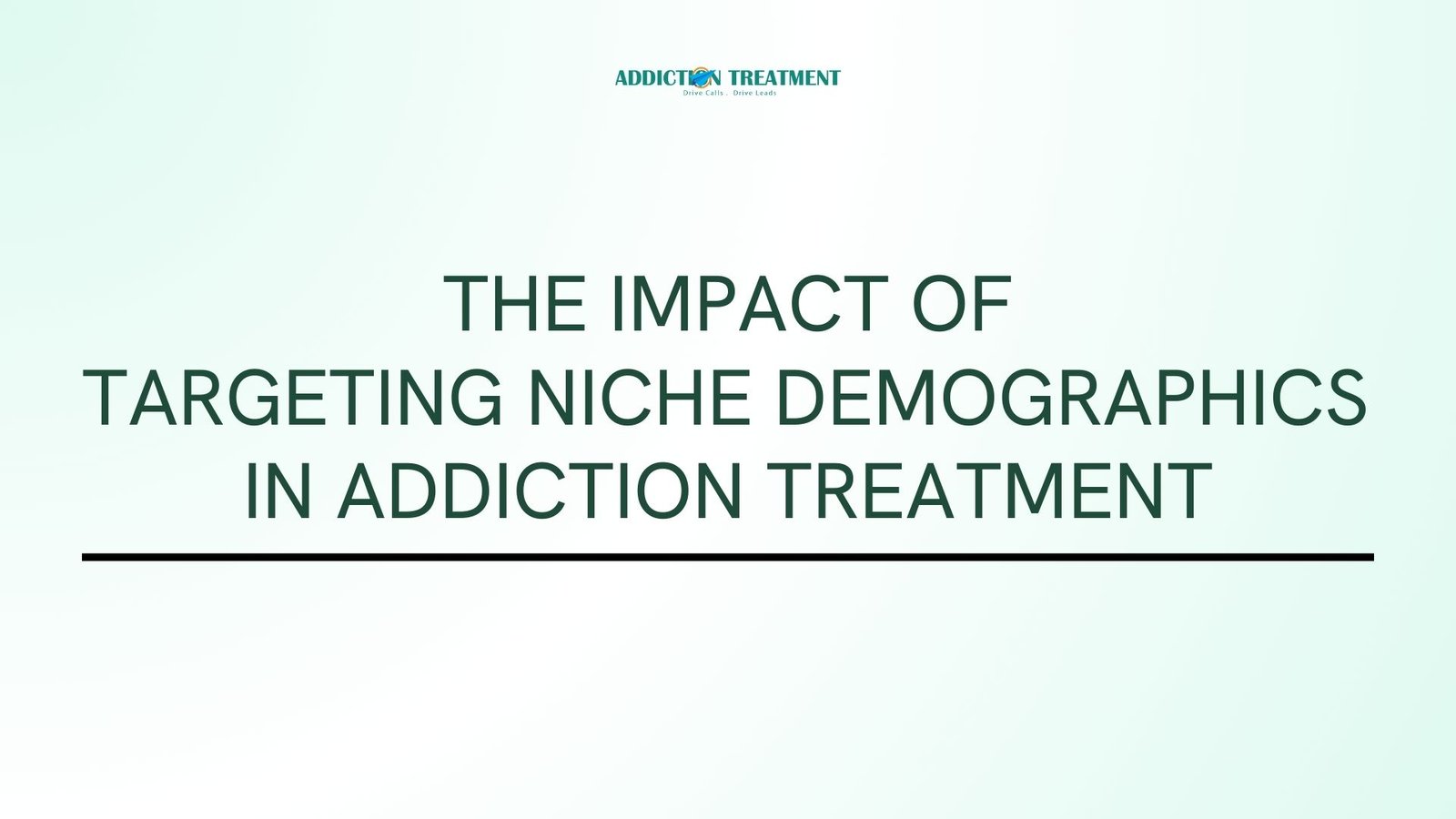The field of addiction treatment is becoming increasingly competitive, with more centers vying to attract individuals in need of help. To stand out and connect with the right audience, many treatment centers are turning to niche demographic targeting. By focusing on specific groups based on factors like age, profession, gender, or cultural background, addiction treatment providers can create more tailored and effective marketing strategies. This article explores the profound impact of targeting niche demographics in addiction treatment and provides actionable insights on implementing this approach.
Why Target Niche Demographics?
Targeting niche demographics allows addiction treatment centers to focus their resources on specific groups of individuals who share similar characteristics or face unique challenges. This approach offers several advantages:
- Personalized Care: Tailored messaging resonates more deeply with niche audiences, making them more likely to engage.
- Improved ROI: Narrowing the focus reduces wasted ad spend by reaching audiences more likely to convert.
- Stronger Community Ties: Connecting with niche groups fosters trust and builds long-term relationships within specific communities.
Key Benefits of Niche Demographic Targeting
1. Higher Engagement Rates
When marketing messages are designed to address the specific needs of a niche demographic, they are more likely to capture attention. For example:
- A campaign targeting working professionals might emphasize flexible treatment schedules.
- Messaging for parents could highlight family-focused therapy programs.
2. Enhanced Conversion Rates
Tailored campaigns often lead to higher conversion rates because the messaging aligns with the audience’s unique concerns. A person from a niche demographic is more likely to take action if they feel the treatment center understands their situation.
3. Stronger Brand Identity
Focusing on niche demographics helps treatment centers position themselves as specialists. A center known for its expertise in treating LGBTQ+ individuals, for instance, can build a strong reputation within that community.
Examples of Niche Demographics in Addiction Treatment
1. Young Adults
Young adults often face unique pressures related to social expectations, career beginnings, and peer influence. Targeted programs for this demographic might include:
- Emphasizing therapies that address social media and technology addiction.
- Highlighting peer-support groups tailored for younger audiences.
2. Professionals and Executives
High-stress professions can lead to addiction issues among professionals and executives. Campaigns targeting this group can focus on:
- Discretion and privacy in treatment.
- Flexible outpatient programs that accommodate work schedules.
3. Veterans and Active Military Personnel
Veterans often face addiction issues linked to PTSD or combat-related stress. Targeted efforts might include:
- Promoting therapies designed to address trauma.
- Highlighting support groups for veterans and their families.
4. LGBTQ+ Community
Members of the LGBTQ+ community may face addiction challenges stemming from stigma and discrimination. Campaigns targeting this demographic should emphasize:
- Safe and inclusive treatment environments.
- Specialized programs addressing issues specific to LGBTQ+ individuals.
Strategies for Targeting Niche Demographics
1. Conduct Audience Research
Understanding the unique challenges and preferences of your target demographic is essential. Use the following methods:
- Surveys and Focus Groups: Gather insights directly from members of the demographic.
- Data Analytics: Use tools like Google Analytics to identify patterns in website traffic and user behavior.
- Social Listening: Monitor social media platforms to understand the conversations happening within your target demographic.
2. Create Personalized Content
Develop content that speaks directly to the concerns and interests of your niche audience. Examples include:
- Blog Posts: Write about issues relevant to the demographic, such as “The Role of Family Support in Young Adult Recovery.”
- Video Testimonials: Share success stories from individuals within the demographic.
- Downloadable Resources: Offer guides, eBooks, or infographics tailored to the audience’s specific needs.
3. Utilize Targeted Advertising
Digital advertising platforms like Google and Facebook allow for precise targeting based on demographics, interests, and behaviors. Best practices include:
- Demographic Filters: Use age, location, and gender targeting to narrow your audience.
- Interest-Based Ads: Target users based on their browsing habits and online interactions.
- Retargeting Campaigns: Re-engage users who have shown interest in your services but haven’t converted.
4. Collaborate with Community Organizations
Building partnerships with organizations that cater to your target demographic can enhance your credibility and reach. For example:
- Partnering with LGBTQ+ advocacy groups for outreach programs.
- Collaborating with veterans’ organizations to connect with military personnel.
5. Leverage Social Media
Social media platforms are excellent for engaging niche demographics through organic and paid campaigns. Consider:
- Joining groups or forums where your target audience is active.
- Creating shareable content, such as infographics or short videos.
- Running targeted ads that lead users to specialized landing pages.
Challenges of Targeting Niche Demographics
While niche demographic targeting offers many benefits, it also comes with challenges:
1. Smaller Audience Size
Focusing on a niche group limits your audience size. To address this, create highly targeted campaigns that maximize engagement and conversion rates.
2. Compliance and Sensitivity
Marketing to certain groups, such as veterans or LGBTQ+ individuals, requires a sensitive approach to avoid appearing exploitative. Ensure all messaging is respectful and aligned with industry regulations.
3. Higher Cost Per Lead
Specialized campaigns may have a higher cost per lead compared to broader campaigns. However, the improved lead quality often justifies the investment.
Measuring the Impact of Niche Demographic Targeting
To assess the success of your efforts, track the following metrics:
- Conversion Rate: Measure how effectively your campaigns turn leads into clients.
- Engagement Rate: Monitor likes, shares, and comments on social media to gauge interest.
- Lead Quality: Evaluate the quality of inquiries by analyzing call durations, insurance coverage, or admission rates.
- ROI: Compare the revenue generated from targeted campaigns to the cost of running them.
Future Trends in Niche Demographic Targeting
As technology evolves, the ability to target niche demographics will become even more precise. Future trends include:
- AI-Driven Personalization: Advanced algorithms will provide deeper insights into audience behavior, enabling even more tailored messaging.
- Voice Search Optimization: With the rise of voice search, optimizing for conversational keywords will help reach niche groups.
- Programmatic Advertising: Automated ad buying will make it easier to target specific demographics with high accuracy.
Conclusion
Targeting niche demographics is a powerful strategy for addiction treatment centers to improve lead quality and build meaningful connections with their audience. By focusing on the unique needs of specific groups, treatment centers can create personalized, impactful campaigns that drive better outcomes. As digital marketing tools continue to advance, now is the time to embrace this approach and set your center apart in an increasingly competitive landscape.


Leave a Reply